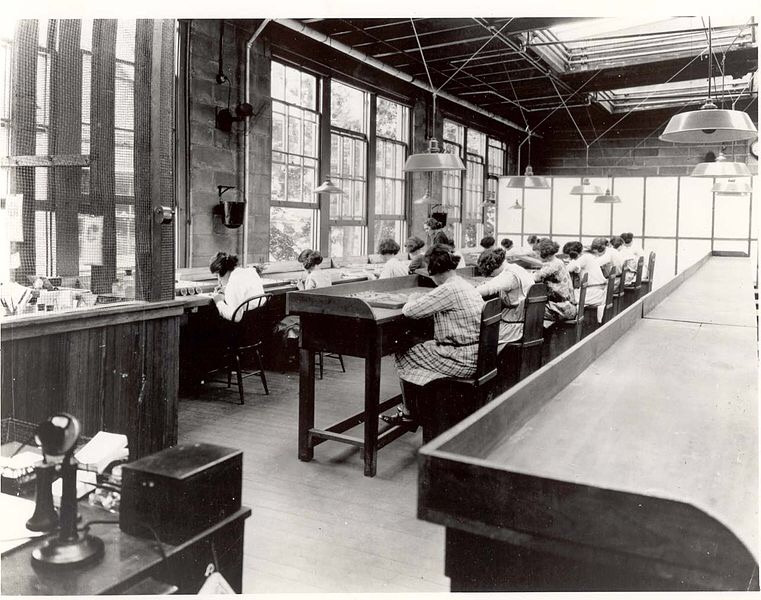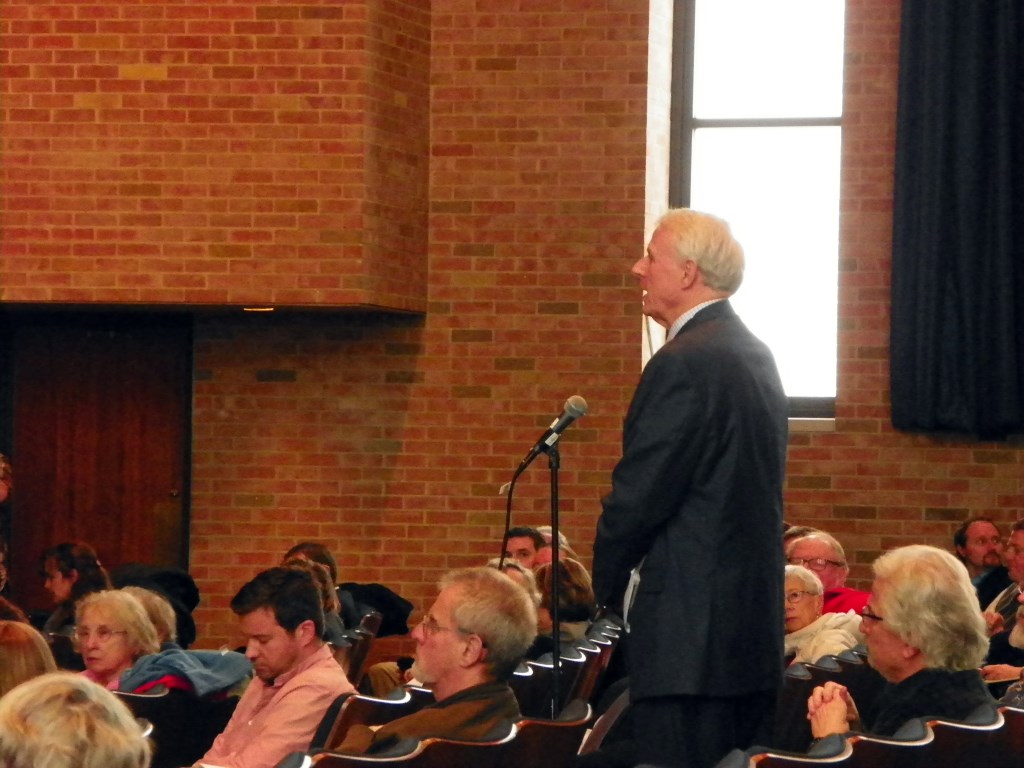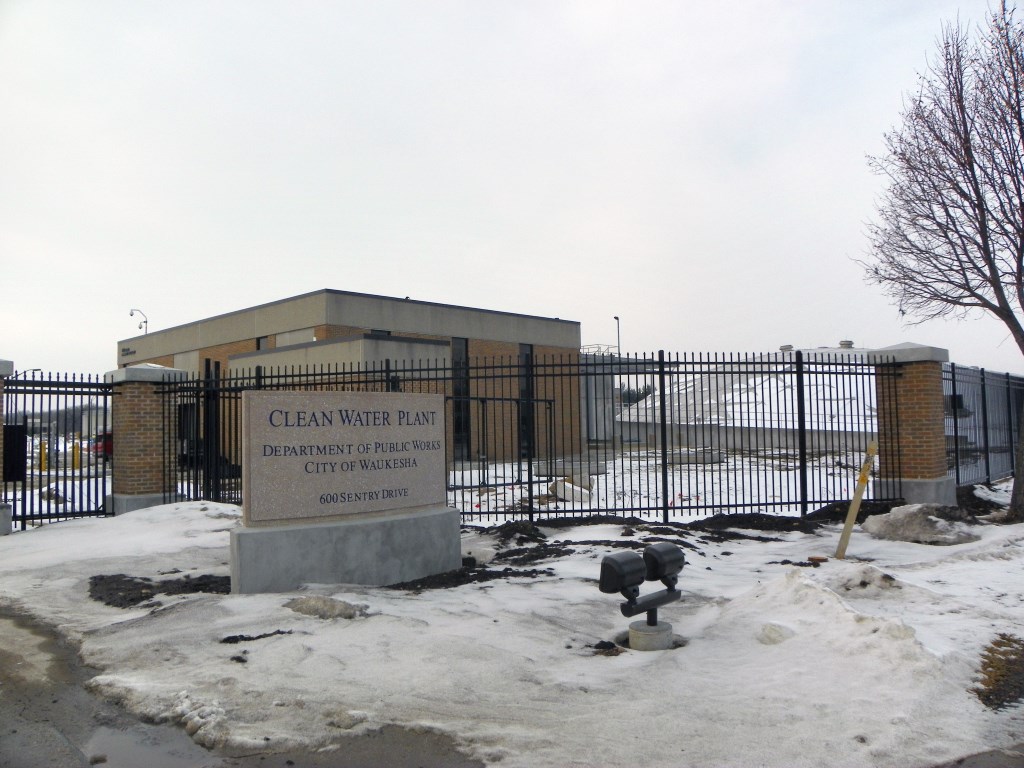State’s Drinking Water Has Radium Problem
Waukesha is among dozens of communities in Wisconsin with radium-tainted well water.
Health risks of radium
According to the federal Centers for Disease Control and Prevention, radium is a known carcinogen at high levels, causing bone, breast and liver cancer. But there is little research evaluating low-dose, long-term exposure in drinking water.

From 1917 to 1926, U.S. Radium Corp. in Orange, New Jersey, produced glow-in-the-dark products. The plant employed over a hundred workers, mainly women, to paint radium-lighted watches and instruments. Dozens of “radium girls” came down with radiation sickness and died, demonstrating the dangers of high-level radium exposure. Low-level exposure in drinking water remains understudied. Photo courtesy of Rutgers University.
Small amounts of radium can accumulate in the human skeleton over time, damaging bones and tissues, according to the U.S. Geological Survey.
A person who drinks two liters of water containing 5 pCi/L of radium every day for 70 years has a 1 in 10,000 risk for developing fatal cancer, according to the geological survey. Other harms of drinking radium-tainted water include anemia, cataracts and fractured teeth, according to the CDC.
“The relationship between the amount of radium that you are exposed to and the amount of time necessary to produce these effects is not known,” the CDC cautions. “Although there is some uncertainty as to how much exposure to radium increases your chances of developing a harmful health effect, the greater the total amount of your exposure to radium, the more likely you are to develop one of these diseases.”
Given the uncertainty about how much radium is harmful to consume, some have argued that the current regulations are too strict. But that question was decided 12 years ago in a nationally watched lawsuit in which Waukesha and Sussex tried sued to block updates to radium rules in 2000. The communities charged, among other things, that the EPA used flawed science in determining the dangers of radium. The U.S. District Court of Appeals for the District of Columbia disagreed, turning down the communities’ challenge.
Kevin Masarik, UW-Stevens Point groundwater education specialist, credited stringent drinking water standards with keeping the risk of illness from radium low.
“I think it may look like low risk partially because of the success of drinking water standards reducing radium exposure for large numbers of people on municipal water supplies,” he said.
Geology, pumping tied to radium
A naturally occurring element, radium is found throughout the environment. Overpumping of the sandstone aquifer where radium resides is largely to blame for the high radium levels, experts say.
“Water moves through that aquifer slower than it does in other areas that also contain sandstone aquifers,” according to Timothy Grundl, UW-Milwaukee professor of geosciences. “This can cause bigger problems because the water has more time to pick up contaminants.”
Growing populations and increased demand for water have caused the aquifer to become one of the most depleted in the country, according to Ezra Meyer, a water resource specialist at the Madison-based environmental group, Clean Wisconsin.
Although groundwater levels have rebounded some in the last decade, communities have had to drill deeper wells to tap into an aquifer that researchers say has dropped by nearly 500 feet since the late 1800s. In the process, communities run into more radium because contamination tends to increase the deeper the well is drilled, said Steve Elmore, the state DNR’s public water supply section chief.
Overpumping of the aquifer also can alter the water’s natural flow.
“Water that used to flow to Lake Michigan is now flowing west,” said U.S. Geological Survey hydrologist Daniel Feinstein. “Part of the reason we are seeing high levels of radium is that the flow field was energized by overpumping.”
Of the more than 40 communities in Wisconsin that have had wells exceed the federal limit, all but Waukesha have been able to comply or expect to, according to Todd Ambs, director of the Healing Our Waters-Great Lakes Coalition, which includes more than 100 environmental and other groups dedicated to restoring the health of the Great Lakes. But Waukesha has said it will not meet its court-ordered 2018 deadline to comply.
The costs of radium
There are a variety of ways radium levels can be brought into compliance, at varying costs. Municipalities can use expensive methods such as water treatment or diluting water from deep wells with water from shallower ones; Waukesha is using both strategies. Homeowners with private wells also can use water softeners to remove radium.

Milwaukee Mayor Tom Barrett speaks at a public hearing in Waukesha in February about Waukesha’s proposal to use Lake Michigan water to replace radium-tainted groundwater. Governors of eight Great Lakes states must approve the controversial proposal. Barrett said Milwaukee would consider selling water to Waukesha but only if it confines its water service area to the Waukesha city limits. Photo by Matt Campbell of the Wisconsin Center for Investigative Journalism.
The city of Brookfield has been treating one of its 22 wells since 2006 for radium contamination, said Thomas Grisa, director public works for the city. Brookfield has periodically run into radium levels that range from 6 to 8 pCi/L, compared to the federal limit of 5 pCi/L, but “dealt with it right away,” Grisa said.
Brookfield spends about $111,000 a year on radium treatment and testing. Radium accounts for 2.7 percent of customers’ water bills, or about $8 a year, he said.
Grisa does not believe many of Brookfield’s residents are drinking water contaminated with radium as it is effectively treated through water softening.
“It’s the law and we have to comply,” Grisa said. “But we seem to have taken on the idea in America that nothing can be in our drinking water, when perhaps that money could be better spent.”

The Waukesha Water Utility estimates it will cost more than $200 million to divert Lake Michigan water to replace water from the city’s radium-contaminated wells. The proposal, which still must be ratified by all eight Great Lakes governors, is expected to double or triple customers’ water bills, officials say. Photo by Matt Campbell of the Wisconsin Center for Investigative Journalism.
Waukesha is now counting on diversion of Lake Michigan water, saying it is the only reasonable alternative to provide safe drinking water for its residents.
Depending on how much funding the federal government kicks in, average water bills would rise from $27 a month to between $50 and $90 a month, said Daniel Duchniak, general manager of the Waukesha Water Utility. Even if Waukesha gets federal funding for up to 25 percent of the cost, he said, “We expect that water bills will at least double and potentially triple.”
Waukesha officials say alternatives pushed by opponents, such as stepped up water conservation, are not enough. And drawing more water from shallow wells to avoid radium, Duchniak said, would cause “permanent adverse environmental impacts” to area wetlands and streams.
Mary Kate McCoy graduated from the University of Wisconsin-Madison School of Journalism and Mass Communication in May 2015. She currently works at Wisconsin Public Radio. Reporters Silke Schmidt and Dee J. Hall contributed to this report. The story was produced as part of journalism classes participating in The Confluence, a collaborative project involving the Wisconsin Center for Investigative Journalism and UW-Madison School of Journalism and Mass Communication. The nonprofit Center (www.WisconsinWatch.org) collaborates with Wisconsin Public Radio, Wisconsin Public Television, other news media and the UW-Madison School of Journalism and Mass Communication. All works created, published, posted or disseminated by the Center do not necessarily reflect the views or opinions of UW-Madison or any of its affiliates.
Article Continues - Pages: 1 2
Tainted Water
-
Fecal Microbes In 60% of Sampled Wells
 Jun 12th, 2017 by Coburn Dukehart
Jun 12th, 2017 by Coburn Dukehart
-
State’s Failures On Lead Pipes
 Jan 15th, 2017 by Cara Lombardo and Dee J. Hall
Jan 15th, 2017 by Cara Lombardo and Dee J. Hall
-
Lax Rules Expose Kids To Lead-Tainted Water
 Dec 19th, 2016 by Cara Lombardo and Dee J. Hall
Dec 19th, 2016 by Cara Lombardo and Dee J. Hall






















This is why its very important for the government to get involved in land use. The government needs to protect its people from having homes that will put them in harm’s way. For me this isn’t about urban vs suburban but how to most efficiently live our lives.
Since the radium belt cannot support a large population lets leave this area to agriculture and wildlife and stop allowing developers to build subdivisions there. If you want to live in a subdivision that’s just fine but lets locate them in an area that can handle them.